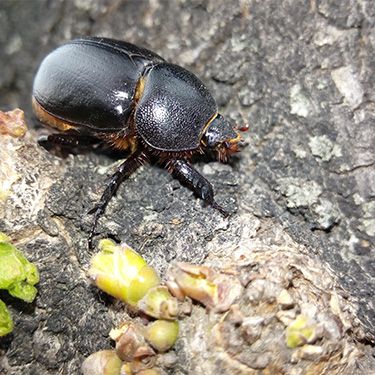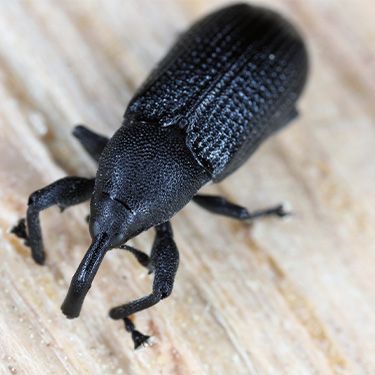9 Minute(s) read
Protect your lawn from beetles, grubs, mites and other pests
Even a novice gardener knows that there’s no such thing as a perfect lawn, not really. Where there are plants, flowers, trees, roots, fruits and vegetables, nasty little critters are scampering to gobble them up. If you don’t control lawn pests quickly, they’ll leave holes and brown patches across your lawn, eat through your seeds and saplings, ruin your fruit and flowers and leave you with a sad, damaged lawn.
Our easy-to-follow guide will outline Australia's 14 most common types of lawn and garden pests. We’ll teach you how to identify and get rid of them.
The lawn pests we’ll teach you about are:
- African black beetles
- Ants
- Aphids
- Billbugs
- Couch grass mites
- Garden weevils
- Lawn grubs
- Leafhoppers
- Mealybugs
- Mole crickets
- Scale insects
- Snails & slugs
- Sod webworms
- Leeches
If you’re after an effective insecticide to treat common lawn pests, browse through our online insecticide shop.
The 9 most common lawn pests: identify and control
1. African black beetles (Heteronychus arator)

The African black beetle (also known as the black lawn beetles) is easily identified by their shiny black carapace. They are approximately 15mm long. They typically favour eating grass turf, but you’ll find them munching on flowers, tree leaves and shrubs, too.
The African black beetle tends to lie dormant during the colder seasons and will emerge during spring and summer. If you notice them in your garden during the warmer months, you can test for an infestation with a tea towel: simply leave the wet towel on your lawn overnight. In the morning, you’ll see the beetles, which love moisture, have gathered around the cloth.
How to get rid of African black beetles in your lawn
The best way to eliminate African black beetles from lawns is with an insecticide such as Acelepryn GR.
If you prefer a natural solution to protect your turf against African black beetles, chickens will pick your lawn clean of them.
2. Ants (Formicidae)

Ants are typically a great sign of a healthy lawn. However, there are instances in which they can be more of a hazard than a benefit. If they’re the biting kind, they can be a nuisance to kids, pets and anyone who just wants to lie down on your grass and enjoy the sun.
The problem with ants is that the healthier your soil, the better they like it. Ants love well-drained, healthy lawns that make it easier for them to build their colonies. Ants can damage your lawn by creating expansive colonies under your soil, which can shred your turf’s roots. You’ll soon notice large patches of dead brown turf. If you do, keep an eye out for long lines of marching ants.
How to get rid of ants in your lawn
In almost all cases, ants in a garden should be left alone. They’ll till your soil for you and eat many of the lawn pests you do have to worry about.
But if you do need to eliminate them, you’ll need an ant-specific insecticide. If you’d prefer a natural solution, you might try pouring boiling water down the mouth of a colony or wherever you suspect their colony is on your lawn. You can also use a mix of water and dishwashing detergent. Either way, this will cause some damage to your lawn.
3. Couch grass mites
Couch grass mites are microscopic mites that, as the name suggests, love couch grass. Couch mites feed and breed during the summer and love a hot, dry lawn — easy to come by under the Australian sun.
Being microscopic, you won’t be able to identify couch grass mites by eye. What you will notice are the symptoms of their presence. First, you’ll notice the yellowing of the grass from the tips down. Then, the grass of the infected area will be noticeably shorter than the surrounding turf and more tufted, too. As the grass dies, weeds will swarm the area.
How to get rid of couch grass mites in your lawn
To control couch grass mites, first start with an effective miticide. Then, mow the lawn to get rid of the infected dead grass. Since these pests prefer dry grass, keeping your lawn well watered and fertilised will create an inhospitable environment for them while stimulating new growth to undo their damage.
4. Garden weevil (Curculionoidea)

Also known as billbugs, weevils are an extremely common pest in lawns across Australia. Weevils adore beautiful green grass lawns, which they need to breed. This pesky lawn pest will bore into the blades and stems of your lawn turf and lay its eggs within — they’ll then continue eating the grass as their young gestate.
You can easily identify them by their ‘bill’, which is the downward curving proboscis at the tip of their head.
How to get rid of weevils and billbugs in your lawn
You can protect your lawn from billbugs using Grub Guard Ultimate. Easy to spread and highly effective, this insecticide provides up to 6 months of protection from weevils.
5. Lawn grubs

Grubs are the larvae of an adult beetle, such as an African black beetle. Often a matter of millimetres in length and a pale white or cream colour, they’ll often curl into a little white ‘c’ when disturbed, which is why they are often known as white curl grubs.
Though early in their life cycle, these root-feeding grubs can wreak havoc on your turf. White curl grubs feed on grass roots, and a severe infestation can quite literally separate the turf from the soil — you’ll be able to roll it up like a carpet.
Grub-infested patches of turf will brown and wither away, and you’ll be able to pull the turf loose without any effort.
How to get rid of grubs in your lawn
A generous spread of Grub Guard Ultimate should do the trick.
6. Mole crickets (Gryllotalpa brachyptera)

Mole crickets are brown, 50mm long crickets with distinctive front claws evolved for digging through soil. Though they do feed on turf and flora, the real damage they cause comes from their constant tunneling. Their constant digging through the soil and roots beneath your turf can quickly kill large patches of grass. Mole crickets prefer moist soil, so you will notice them in the spring and early summer before the heat comes.
How to get rid of mole crickets in your lawn
Our Grub Guard Ultimate and Acelepryn GR insecticides will do the trick of protecting your lawn from mole crickets.
7. Snails & slugs

Snails and slugs are extremely common and intensely destructive. The two most common species you’re likely to see in Australia are the grey field slug (Deroceras reticulatum) and the brown snail (Helix aspera). There is little they will not eat — the seedlings, leaves and fruit of practically all grass varieties, plants, and trees will be eaten.
The most common symptoms of snail and slug infestations are the sudden appearance of large holes in the leaves of your plants and decimated vege patches. If you have concrete or stone paths and steps in your garden, you will notice the thin silver trails they leave behind.
How to get rid of slugs and snails in your lawn
Thanks to their size and slow movement, it’s easy to remove snails and slugs by hand and place them in a bowl of salt. For an effective passive solution, fill a plastic cup with beer and bury it to the rim in the centre of your vegetable patch. The beer will attract the snails and slugs, who will slip into the cup and drown.
8. Sod webworm (Herpetogramma)

Sod webworms are caterpillars — the larvae of common brown moths. Though 25mm in length, the pale green-brown body of a sod webworm can be had to spot in a field of grass. What you may notice are the frayed edges of your grass, which is a sign of their feeding, and spots of browning grass where they are breeding. A better way to identify the presence of sod webworms is to look out for tiny brown moths flitting about your lawn.
How to get rid of sod webworms in your lawn
A healthy garden and lawn will attract the sod webworm’s natural predators, including birds, beetles and wasps. However, we also recommend either Grub Guard Ultimate or Acelepryn GR insecticide.
9. Leeches (Hirudinea)

While leeches are not especially destructive towards flora, they can be a nuisance for the people and pets that frequent your lawn. A brisk walk through leech-infested turf can leave you with leeches stuck to your feet and shins.
How to get rid of leeches in your lawn
Leeches tend to breed in bodies of water, such as backyard ponds and water features. We recommend adding a copper sulphate solution to the water to kill them. Copper sulphate can be purchased at most gardening supply stores, and each product will guide you on how to dilute its mix before adding it to your leech-infested water.
Purchase effective pest control products online
At Lilydale Instant Lawn, we’re familiar with all of the most common creepy crawlies that wriggle under and through lawn turf. That’s why we’ve stocked a number of insecticides that we can know work. Order your lawn insecticides online today.
















